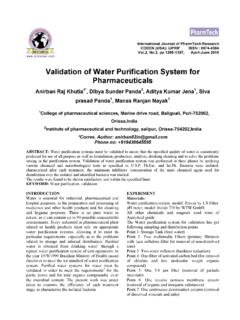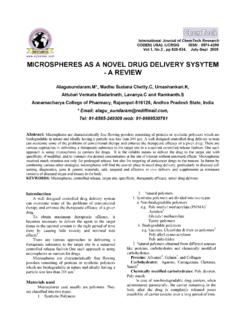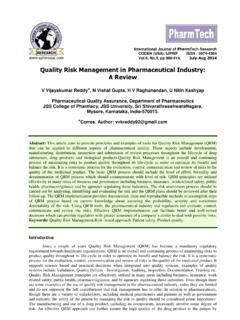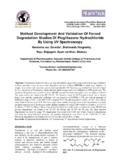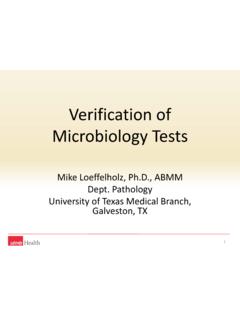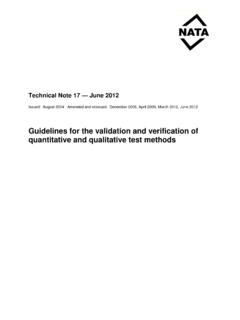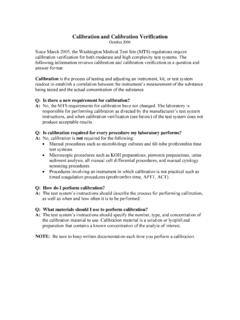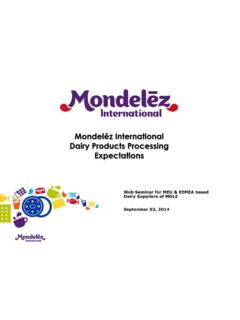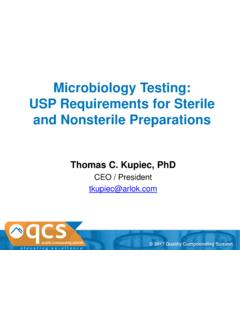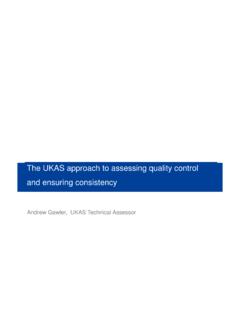Transcription of QUALIFICATION OF TUNNEL STERILIZING MACHINE
1 QUALIFICATION of TUNNEL STERILIZING MachineRam Mohan , N. Vishal Gupta*Pharmaceutical Quality Assurance group, Department of Pharmaceutics,JSS College of Pharmacy, JSS University, Sri Shivarathreeshwara Nagara,Mysuru 570015, Karnataka, IndiaAbstract:Depyrogenation devices, such as tunnels, are used in the pharmaceutical industry toprepare components for aseptic filling. To qualify such devices, various pharmacopoeiasrequire depyrogenation devices to be periodically challenged with high levels of bacterialendotoxin. Although the pharmacopoeias state the acceptance criteria, little consideration isgiven to the practical approach. This work discusses the theoretical concept of depyrogenationand the various tests performed for the QUALIFICATION of Depyrogenation words:Depyrogenation, Bacterial Endotoxin, Performance is an important part of the manufacture of pharmaceutical products and is distinct fromsterilization.
2 Sterilization refers to the destruction of living cells. However, the process does not necessarilydestroy microbial by-products and toxins. Endotoxin is one toxin that is extremely heat stable and is notdestroyed by standard sterilization cycles ( , autoclaving). If only sterilization is required to be demonstrated,this can be achieved using biological indicators impregnated with endospores from a heat resistant bacteria( , Bacillus subtilis var. niger [often used for dry heat] or Geobacillus stearothermophilus [often used formoist heat, although the microorganism also has a high resistance to dry heat].2 Depyrogenation by dry heat for glass in the pharmaceutical industry is the primary endotoxindestruction method used.)
3 This process both sterilizes and depyrogenates and is mainly used for glasscomponents. Dry heat involves subjecting the components to a high level of heat (normally between 180 and250 C) for a defined time (the higher the temperature, the shorter the time required). The typical cycle is 250 Cfor not less than 30 minutes. For example, the European Pharmacopoeia in chapter states two possibletime-temperature combinations for depyrogenation: 60 minutes at 200 C or 30 minutes at 250 C. A quantity ofendotoxin destroyed at 250 C for 60 minutes would not necessarily be totally destroyed at 200 C at 60 minutes,based on the non-linearity of the thermal destruction curve. Endotoxin destruction at low temperature is of dry heat devices include ovens and TUNNEL sterilizers.
4 To operate, depyrogenation de-vices require a series of parameters to be controlled. These parameters include laminar airflow controlled byhigh-efficiency particulate air (HEPA) filters, with a specification for air velocity and particulates. Where thedevice is a depyrogenation TUNNEL , the rate of speed ( , minimum, maximum, and nominal) must be measuredand verified. The key function for depyrogenation is temperature control. Such depyrogenation devices requirequalifying as part of validation. This is performed along the familiar lines of design QUALIFICATION , installationqualification, operational QUALIFICATION , and performance QUALIFICATION , as well as annual re-qualifications.
5 Adepyrogenation study is a test of the physical capabilities of a device to depyrogenate an article or device. It isdemonstrated by physical measurements (including temperature) and biological (using bacterial endotoxin). 2 International Journal ofPharmTechResearch CODEN (USA): IJPRIF, ISSN: 0974-4304 , , pp 400-405, 2016N. Vishal Gupta et al/ International Journal of PharmTech Research, 2016,9(3),pp part of the validation, normally at the performance QUALIFICATION stage, depyrogenation devices arebiologically challenged using a known level of a high concentration of Escherichia coli endotoxin.
6 Thepreparation used is a freeze-dried extract from the Gram-negative bacterial cell wall lipopolysaccharide (LPS).The preparation is similar to the control standard endotoxin (CSE) used for routine LAL testing, although theconcentration, once reconstituted, is far qualificationThe first element of the validation of new facilities, systems or equipment could be design QUALIFICATION (DQ).The compliance of the design with GMP should be demonstrated and qualificationInstallation QUALIFICATION (IQ) should be performed on new or modified facilities, systems and should include, but not be limited to the following:(a) Installation of equipment, piping, services and instrumentation checked to current engineering drawings andspecifications;(b) Collection and collation of supplier operating and working instructions and maintenance requirements;(c) Calibration requirements;(d) Verification of materials of qualificationOperational QUALIFICATION (OQ) should follow Installation should include, but not be limited to the following:(a) Tests that have been developed from knowledge of processes, systems and equipment.
7 (b) Tests to include a condition or a set of conditions encompassing upper and lower operating limits,sometimes referred to as worst case completion of a successful Operational QUALIFICATION should allow the finalisation of calibration,operating and cleaning procedures, operator training and preventative maintenance requirements. It shouldpermit a formal "release" of the facilities, systems and qualificationPerformance QUALIFICATION (PQ) should follow successful completion of Installation QUALIFICATION andOperational should include, but not be limited to the following:(a) Tests, using production materials, qualified substitutes or simulated product, that have been developed fromknowledge of the process and the facilities, systems or equipment.
8 (b) Tests to include a condition or set of conditions encompassing upper and lower operating PQ is described as a separate activity, it may in some cases be appropriate to perform it in conjunctionwith of established (in-use) facilities, systems and equipmentEvidence should be available to support and verify the operating parameters and limits for the criticalvariables of the operating equipment. Additionally, the calibration, cleaning, preventative maintenance,operating procedures and operator training procedures and records should be Vishal Gupta et al/ International Journal of PharmTech Research, 2016,9(3),pp for flow of sterilization TUNNEL 1 Washed glass vialsDrying zoneSterilizing zoneCooling zoneFilling tableTest and Its RationaleTable-1.
9 Tests performed and its flow VelocityThe purpose of this test is to measure airflow velocity anduniformity, and supply airflow rates through the HEPA Filter system leakage TestThe purpose of this test is to confirm that the filter system isproperly installed and that leaks have not developed during Belt / Conveyor speedverificationTo ensure the TUNNEL conveyor belt speed meets the requirementsas specified by Nonviable Particle CountThe purpose of this test is to provide acleanliness in the penetration andEndotoxin challenge studyTo ensure and establish the heat Penetration and endotoxin logreduction efficiency of the TUNNEL SterilizerTests, Objective, Procedure and its Acceptance Criteria 1, ObjectiveTo determine that factors that affect cross-sectional air velocity distribution in TUNNEL -ventilated systemand is capable of delivering air velocities, as per the requirement to maintain continuous laminarity of HEPA filter installed in Equipment usedHot air Procedure This test shall be performed by trained person and training record should be attached in report.
10 Performedat least 30 minute. Measure the velocity above the conveyor for the different zone of TUNNEL sterilizer and measure the airvelocity 6 inches below filter. Take the velocity of air at five locations (on centre and four corners) of each zones of sterilizer average velocity for each filter If velocity is not within the limit, inform the manufacturer of the STERILIZING TUNNEL for corrective Acceptance criteriaAir velocity should be maintained within 90 fpm 20% of mean unit velocity for even distribution Vishal Gupta et al/ International Journal of PharmTech Research, 2016,9(3),pp system leakage ObjectiveTo verify the integrity of HEPA filter installed in the sterilization and depyrogenation TUNNEL .
